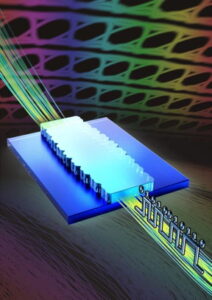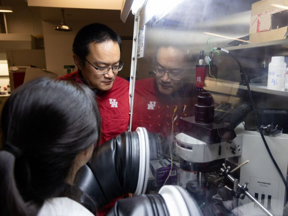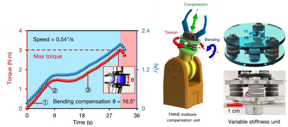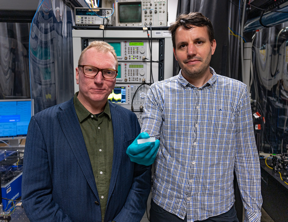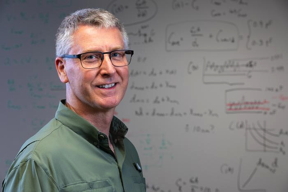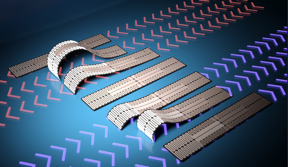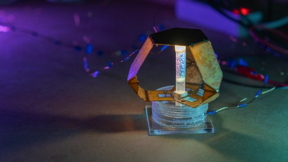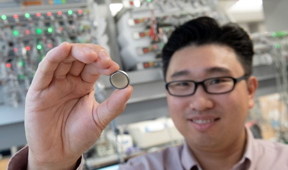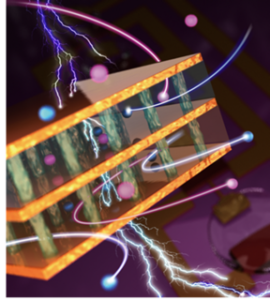Home > Press > A new qubit platform is created atom by atom
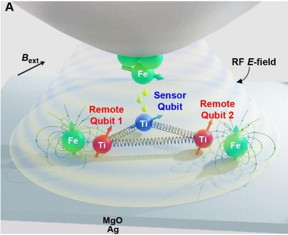 |
| The STM tip (Fe) operates the sensor qubit and romote qubits which creates the new multiple qubit platform. CREDIT Institute for Basic Science |
Abstract:
Researchers at the IBS Center for Quantum Nanoscience (QNS) at Ewha Womans University have accomplished a groundbreaking step forward in quantum information science. In partnership with teams from Japan, Spain, and the US, they created a novel electron-spin qubit platform, assembled atom-by-atom on a surface. This breakthrough was published in the journal Science on 2023/10/06.
A new qubit platform is created atom by atom
Seoul, Republic of Korea | Posted on October 6th, 2023
Unlike previous atomic quantum devices on surfaces where only a single qubit could be controlled, the researchers at QNS successfully demonstrated the ability to control multiple qubits simultaneously, enabling the application of single-, two-, and three-qubit gates.
Qubits, the fundamental units of quantum information, are key to quantum applications such as quantum computing, sensing, and communication. PHARK Soo-hyon, one of the QNS principal investigators, highlights the significance of this project. “To date, scientists have only been able to create and control a single qubit on a surface, making this a major step forward towards multi-qubit systems,” he stated.
Led by BAE Yujeong, PHARK Soo-hyon, and director Andreas HEINRICH, QNS developed this novel platform, which consists of individual magnetic atoms placed on a pristine surface of a thin insulator. These atoms can be precisely positioned using the tip of a scanning tunneling microscope (STM) and manipulated with the assistance of electron spin resonance (ESR-STM). This atomic-scale control has allowed researchers to manipulate quantum states coherently. They also established the possibility of controlling remote qubits, opening the path to scaling up to tens or hundreds of qubits in a defect-free environment.
BAE Yujeong pointed out, “It is truly amazing that we can now control the quantum states of multiple individual atoms on surfaces at the same time”. The atomic-scale precision of this platform allows for the remote manipulation of the atoms to perform qubit operations individually, without moving the tip of the STM.
This research marks a significant departure from other qubit platforms, such as photonic devices, ion and atom traps, and superconducting devices. One of the unique benefits of this surface-based electron-spin approach is the myriad of available spin species and the vast variety of two-dimensional geometries that can be precisely assembled.
Looking forward, the researchers anticipate quantum sensing, computation, and simulation protocols using these precisely assembled atomic architectures. Altogether, the work by the QNS researchers is expected to usher in a new era of atomic-scale control in quantum information science, cementing Korea’s position as a global leader in the field.
####
For more information, please click here
Contacts:
William Suh
Institute for Basic Science
Office: 82-010-379-37830
Copyright © Institute for Basic Science
If you have a comment, please Contact us.
Issuers of news releases, not 7th Wave, Inc. or Nanotechnology Now, are solely responsible for the accuracy of the content.
| Related Links |
| Related News Press |
News and information
![]() Observation of left and right at nanoscale with optical force October 6th, 2023
Observation of left and right at nanoscale with optical force October 6th, 2023
![]() The efficient perovskite cells with a structured anti-reflective layer – another step towards commercialization on a wider scale October 6th, 2023
The efficient perovskite cells with a structured anti-reflective layer – another step towards commercialization on a wider scale October 6th, 2023
![]() Super-efficient laser light-induced detection of cancer cell-derived nanoparticles: Skipping ultracentrifugation, detection time reduced from hours to minutes! October 6th, 2023
Super-efficient laser light-induced detection of cancer cell-derived nanoparticles: Skipping ultracentrifugation, detection time reduced from hours to minutes! October 6th, 2023
![]() Successful morphing of inorganic perovskites without damaging their functional properties October 6th, 2023
Successful morphing of inorganic perovskites without damaging their functional properties October 6th, 2023
Possible Futures
![]() Discovery made by University of Warsaw scientists may enable network interface for quantum computers October 6th, 2023
Discovery made by University of Warsaw scientists may enable network interface for quantum computers October 6th, 2023
![]() The medicine of the future could be artificial life forms October 6th, 2023
The medicine of the future could be artificial life forms October 6th, 2023
![]() Successful morphing of inorganic perovskites without damaging their functional properties October 6th, 2023
Successful morphing of inorganic perovskites without damaging their functional properties October 6th, 2023
Chip Technology
![]() Twisted science: NIST researchers find a new quantum ruler to explore exotic matter October 6th, 2023
Twisted science: NIST researchers find a new quantum ruler to explore exotic matter October 6th, 2023
![]() Successful morphing of inorganic perovskites without damaging their functional properties October 6th, 2023
Successful morphing of inorganic perovskites without damaging their functional properties October 6th, 2023
![]() Interdisciplinary: Rice team tackles the future of semiconductors Multiferroics could be the key to ultralow-energy computing October 6th, 2023
Interdisciplinary: Rice team tackles the future of semiconductors Multiferroics could be the key to ultralow-energy computing October 6th, 2023
Quantum Computing
![]() Discovery made by University of Warsaw scientists may enable network interface for quantum computers October 6th, 2023
Discovery made by University of Warsaw scientists may enable network interface for quantum computers October 6th, 2023
![]() Training quantum computers: physicists win prestigious IBM Award September 8th, 2023
Training quantum computers: physicists win prestigious IBM Award September 8th, 2023
![]() Machine learning contributes to better quantum error correction September 8th, 2023
Machine learning contributes to better quantum error correction September 8th, 2023
Discoveries
![]() Super-efficient laser light-induced detection of cancer cell-derived nanoparticles: Skipping ultracentrifugation, detection time reduced from hours to minutes! October 6th, 2023
Super-efficient laser light-induced detection of cancer cell-derived nanoparticles: Skipping ultracentrifugation, detection time reduced from hours to minutes! October 6th, 2023
![]() Twisted science: NIST researchers find a new quantum ruler to explore exotic matter October 6th, 2023
Twisted science: NIST researchers find a new quantum ruler to explore exotic matter October 6th, 2023
![]() Discovery made by University of Warsaw scientists may enable network interface for quantum computers October 6th, 2023
Discovery made by University of Warsaw scientists may enable network interface for quantum computers October 6th, 2023
![]() The medicine of the future could be artificial life forms October 6th, 2023
The medicine of the future could be artificial life forms October 6th, 2023
Announcements
![]() Observation of left and right at nanoscale with optical force October 6th, 2023
Observation of left and right at nanoscale with optical force October 6th, 2023
![]() The efficient perovskite cells with a structured anti-reflective layer – another step towards commercialization on a wider scale October 6th, 2023
The efficient perovskite cells with a structured anti-reflective layer – another step towards commercialization on a wider scale October 6th, 2023
![]() Super-efficient laser light-induced detection of cancer cell-derived nanoparticles: Skipping ultracentrifugation, detection time reduced from hours to minutes! October 6th, 2023
Super-efficient laser light-induced detection of cancer cell-derived nanoparticles: Skipping ultracentrifugation, detection time reduced from hours to minutes! October 6th, 2023
![]() Twisted science: NIST researchers find a new quantum ruler to explore exotic matter October 6th, 2023
Twisted science: NIST researchers find a new quantum ruler to explore exotic matter October 6th, 2023
Interviews/Book Reviews/Essays/Reports/Podcasts/Journals/White papers/Posters
![]() Observation of left and right at nanoscale with optical force October 6th, 2023
Observation of left and right at nanoscale with optical force October 6th, 2023
![]() The efficient perovskite cells with a structured anti-reflective layer – another step towards commercialization on a wider scale October 6th, 2023
The efficient perovskite cells with a structured anti-reflective layer – another step towards commercialization on a wider scale October 6th, 2023
![]() Super-efficient laser light-induced detection of cancer cell-derived nanoparticles: Skipping ultracentrifugation, detection time reduced from hours to minutes! October 6th, 2023
Super-efficient laser light-induced detection of cancer cell-derived nanoparticles: Skipping ultracentrifugation, detection time reduced from hours to minutes! October 6th, 2023
![]() Twisted science: NIST researchers find a new quantum ruler to explore exotic matter October 6th, 2023
Twisted science: NIST researchers find a new quantum ruler to explore exotic matter October 6th, 2023
Quantum nanoscience
![]() A quantum leap in mechanical oscillator technology August 11th, 2023
A quantum leap in mechanical oscillator technology August 11th, 2023
![]() Electron collider on a chip June 30th, 2023
Electron collider on a chip June 30th, 2023
- SEO Powered Content & PR Distribution. Get Amplified Today.
- PlatoData.Network Vertical Generative Ai. Empower Yourself. Access Here.
- PlatoAiStream. Web3 Intelligence. Knowledge Amplified. Access Here.
- PlatoESG. Carbon, CleanTech, Energy, Environment, Solar, Waste Management. Access Here.
- PlatoHealth. Biotech and Clinical Trials Intelligence. Access Here.
- Source: http://www.nanotech-now.com/news.cgi?story_id=57402
- :has
- :is
- :not
- :where
- $UP
- 10
- 21st
- 26
- 30th
- 6th
- 7th
- 8th
- a
- ability
- Able
- accomplished
- accuracy
- adverse
- allowed
- allows
- also
- altogether
- amazing
- and
- Another
- anticipate
- Application
- applications
- approach
- ARE
- artificial
- AS
- assembled
- Assistance
- At
- atom
- AUGUST
- available
- basic
- BE
- been
- benefits
- Better
- between
- breakthrough
- BRIDGE
- by
- CAN
- Cancer
- Cells
- cementing
- Center
- CGI
- click
- COM
- comment
- commercialization
- Communication
- Complement
- computation
- computers
- computing
- consists
- content
- contributes
- control
- controlled
- controlling
- could
- create
- created
- creates
- credit
- damaging
- dance
- Date
- demonstrated
- Design
- Detection
- developed
- Devices
- Director
- discover
- do
- dynamics
- effects
- efficient
- Electronic
- enable
- enabling
- end
- Environment
- Era
- error
- established
- Ether (ETH)
- Exotic
- expected
- experiments
- explore
- Fe
- fewer
- field
- Find
- For
- Forward
- Frequency
- from
- functional
- fundamental
- future
- Gates
- generation
- gif
- Global
- groundbreaking
- Harnessing
- Have
- he
- highlights
- HOURS
- http
- HTTPS
- Hundreds
- IBM
- if
- in
- Inc.
- individual
- Individually
- information
- Institute
- Interface
- Investigators
- Japan
- journal
- July
- june
- Key
- korea
- Korea’s
- laser
- lasers
- layer
- lead
- leader
- Leap
- learning
- left
- Life
- links
- made
- major
- make
- Making
- manipulated
- Manipulation
- May..
- mechanical
- medicine
- metal
- Microscope
- more
- moving
- multiple
- myriad
- nanotechnology
- nearly
- net
- network
- New
- news
- nexus
- nist
- Noise
- novel
- now
- nuclear
- october
- of
- Offers
- on
- ONE
- only
- opening
- operates
- Operations
- or
- Other
- out
- Partnership
- path
- perform
- PHP
- placed
- platform
- Platforms
- plato
- Plato Data Intelligence
- PlatoData
- please
- position
- positioned
- possibility
- Post
- posted
- potential
- precisely
- Precision
- press
- Press Release
- prestigious
- previous
- Principal
- project
- promising
- properties
- protocols
- published
- Quantum
- quantum computers
- quantum computing
- quantum information
- Qubit
- qubits
- random
- range
- RE
- reactions
- reduce
- Reduced
- release
- Releases
- remote
- Republic
- research
- researchers
- resonance
- responsible
- return
- reveal
- Revealed
- Rice
- right
- safer
- same
- Save
- scaling
- scanning
- Science
- scientists
- Search
- Semiconductors
- Seoul
- September
- Share
- Shows
- side
- significance
- significant
- simulation
- simultaneously
- single
- solely
- Spain
- Spin
- start
- stated
- States
- Step
- Strategy
- structured
- Study
- submit
- Successfully
- such
- Surface
- Systems
- Tackles
- team
- teams
- Technologies
- Technology
- tens
- that
- The
- The Future
- their
- These
- they
- this
- time
- tip
- to
- towards
- traps
- truly
- unique
- units
- university
- unwanted
- us
- using
- variety
- Vast
- Voltage
- Warsaw
- was
- Wave
- we
- which
- wide
- Wide range
- wider
- win
- with
- without
- Work
- Yahoo
- you
- zephyrnet










